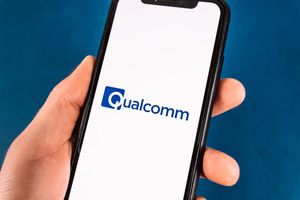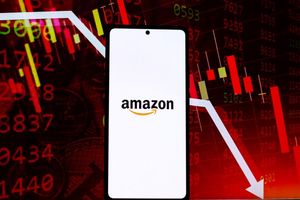
Biopharmaceutical company Bristol Myers Squibb (NYSE: BMY) announced better-than-expected revenue in Q4 CY2024, with sales up 7.5% year on year to $12.34 billion. On the other hand, the company’s full-year revenue guidance of $45.5 billion at the midpoint came in 1.7% below analysts’ estimates. Its non-GAAP profit of $1.67 per share was 13.8% above analysts’ consensus estimates.
Is now the time to buy Bristol-Myers Squibb? Find out by accessing our full research report, it’s free.
Bristol-Myers Squibb (BMY) Q4 CY2024 Highlights:
- Revenue: $12.34 billion vs analyst estimates of $11.58 billion (7.5% year-on-year growth, 6.6% beat)
- Adjusted EPS: $1.67 vs analyst estimates of $1.47 (13.8% beat)
- Management’s revenue guidance for the upcoming financial year 2025 is $45.5 billion at the midpoint, missing analyst estimates by 1.7% and implying -5.8% growth (vs 7.3% in FY2024)
- Adjusted EPS guidance for the upcoming financial year 2025 is $6.70 at the midpoint, missing analyst estimates by 3.1%
- Operating Margin: 1.4%, down from 11.4% in the same quarter last year
- Market Capitalization: $121.1 billion
“We made good progress in 2024, which was capped by a fourth quarter of strong topline growth driven by key products and important pipeline advancements. We also achieved the landmark U.S. approval of Cobenfy last year for the treatment of schizophrenia in adults, and we expect this medicine to have a meaningful impact on patients and the company as a new growth driver,” said Christopher Boerner, Ph.D., board chair and chief executive officer, Bristol Myers Squibb.
Company Overview
Founded in 1887, Bristol-Myers Squibb (NYSE: BMY) is a global biopharmaceutical company that develops medicines to treat cancer, immune disorders, and cardiovascular conditions.
Branded Pharmaceuticals
The branded pharmaceutical industry relies on a high-cost, high-reward business model, driven by substantial investments in research and development to create innovative, patent-protected drugs. Successful products can generate significant revenue streams over their patent life, and the larger a roster of drugs, the stronger a moat a company enjoys. However, the business model is inherently risky, with high failure rates during clinical trials, lengthy regulatory approval processes, and intense competition from generic and biosimilar manufacturers once patents expire. These challenges, combined with scrutiny over drug pricing, create a complex operating environment. Looking ahead, the industry is positioned for tailwinds from advancements in precision medicine, increasing adoption of AI to enhance drug development efficiency, and growing global demand for treatments addressing chronic and rare diseases. However, headwinds include heightened regulatory scrutiny, pricing pressures from governments and insurers, and the looming patent cliffs for key blockbuster drugs. Patent cliffs bring about competition from generics, forcing branded pharmaceutical companies back to the drawing board to find the next big thing.
Sales Growth
A company’s long-term sales performance signals its overall quality. Even a bad business can shine for one or two quarters, but a top-tier one grows for years. Luckily, Bristol-Myers Squibb’s sales grew at a solid 13.1% compounded annual growth rate over the last five years. Its growth beat the average healthcare company and shows its offerings resonate with customers.
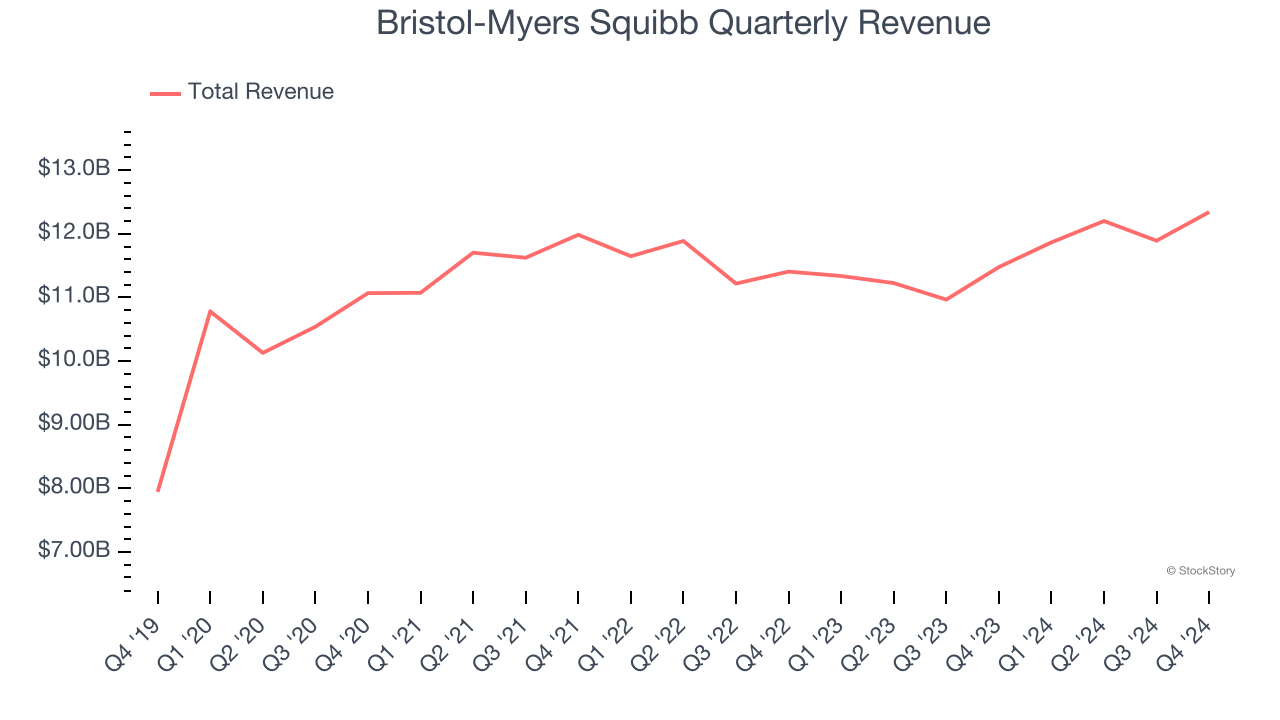
Long-term growth is the most important, but within healthcare, a half-decade historical view may miss new innovations or demand cycles. Bristol-Myers Squibb’s recent history shows its demand slowed as its annualized revenue growth of 2.3% over the last two years is below its five-year trend. 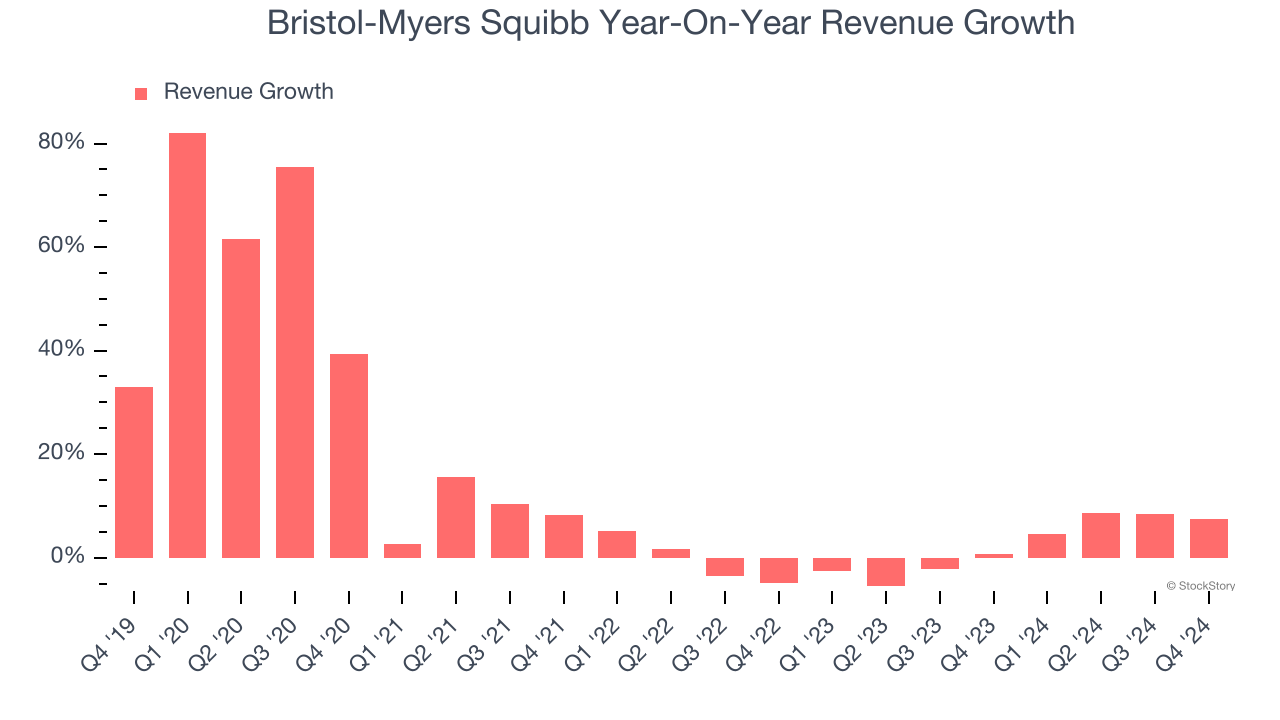
We can better understand the company’s revenue dynamics by analyzing its most important segment, Growth Portfolio. Over the last two years, Bristol-Myers Squibb’s Growth Portfolio revenue averaged 18.1% year-on-year growth. This segment has outperformed its total sales during the same period, lifting the company’s performance.
This quarter, Bristol-Myers Squibb reported year-on-year revenue growth of 7.5%, and its $12.34 billion of revenue exceeded Wall Street’s estimates by 6.6%.
Looking ahead, sell-side analysts expect revenue to decline by 4.5% over the next 12 months, a deceleration versus the last two years. This projection doesn't excite us and suggests its products and services will face some demand challenges.
Today’s young investors won’t have read the timeless lessons in Gorilla Game: Picking Winners In High Technology because it was written more than 20 years ago when Microsoft and Apple were first establishing their supremacy. But if we apply the same principles, then enterprise software stocks leveraging their own generative AI capabilities may well be the Gorillas of the future. So, in that spirit, we are excited to present our Special Free Report on a profitable, fast-growing enterprise software stock that is already riding the automation wave and looking to catch the generative AI next.
Adjusted Operating Margin
Adjusted operating margin is a key measure of profitability. Think of it as net income (the bottom line) excluding the impact of non-recurring expenses, taxes, and interest on debt - metrics less connected to business fundamentals.
Bristol-Myers Squibb has been a well-oiled machine over the last five years. It demonstrated elite profitability for a healthcare business, boasting an average adjusted operating margin of 33.6%.
Looking at the trend in its profitability, Bristol-Myers Squibb’s adjusted operating margin decreased by 40.5 percentage points over the last five years. The company’s two-year trajectory also shows it failed to get its profitability back to the peak as its margin fell by 39.1 percentage points. This performance was poor no matter how you look at it - it shows operating expenses were rising and it couldn’t pass those costs onto its customers.
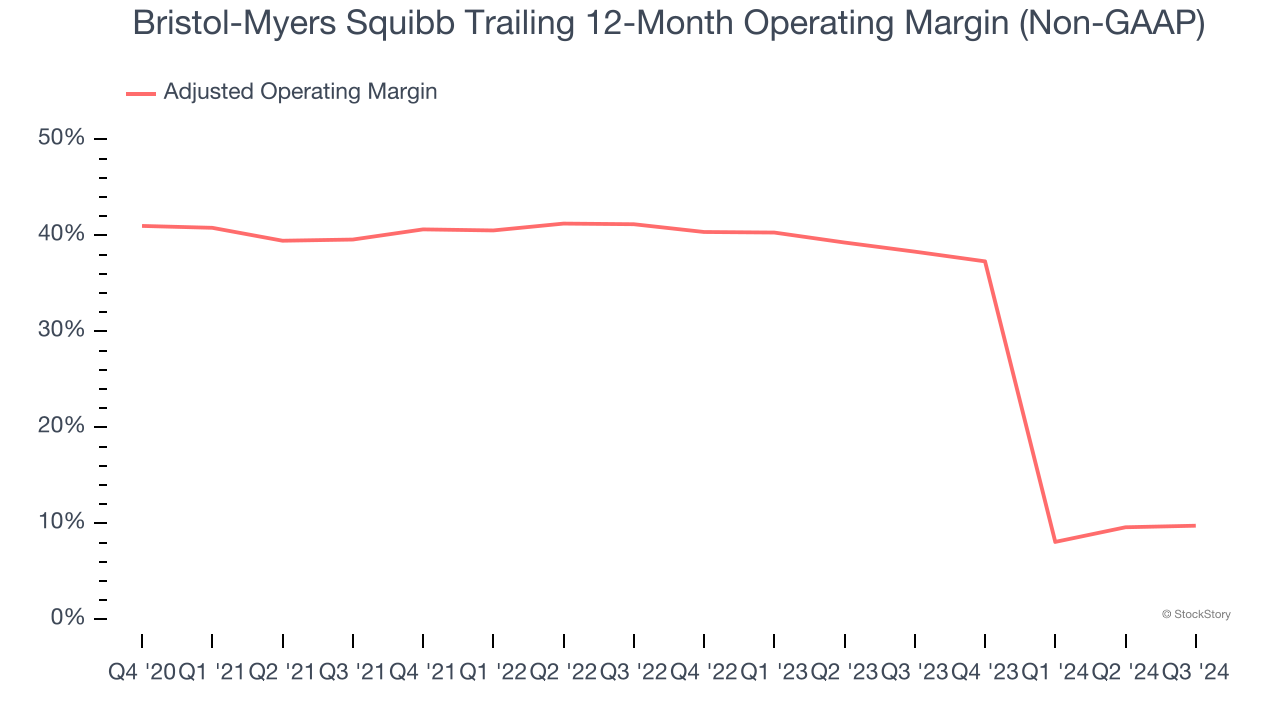
in line with the same quarter last year. This indicates the company’s overall cost structure has been relatively stable.
Earnings Per Share
We track the long-term change in earnings per share (EPS) for the same reason as long-term revenue growth. Compared to revenue, however, EPS highlights whether a company’s growth is profitable.
Sadly for Bristol-Myers Squibb, its EPS declined by 24.8% annually over the last five years while its revenue grew by 13.1%. This tells us the company became less profitable on a per-share basis as it expanded.
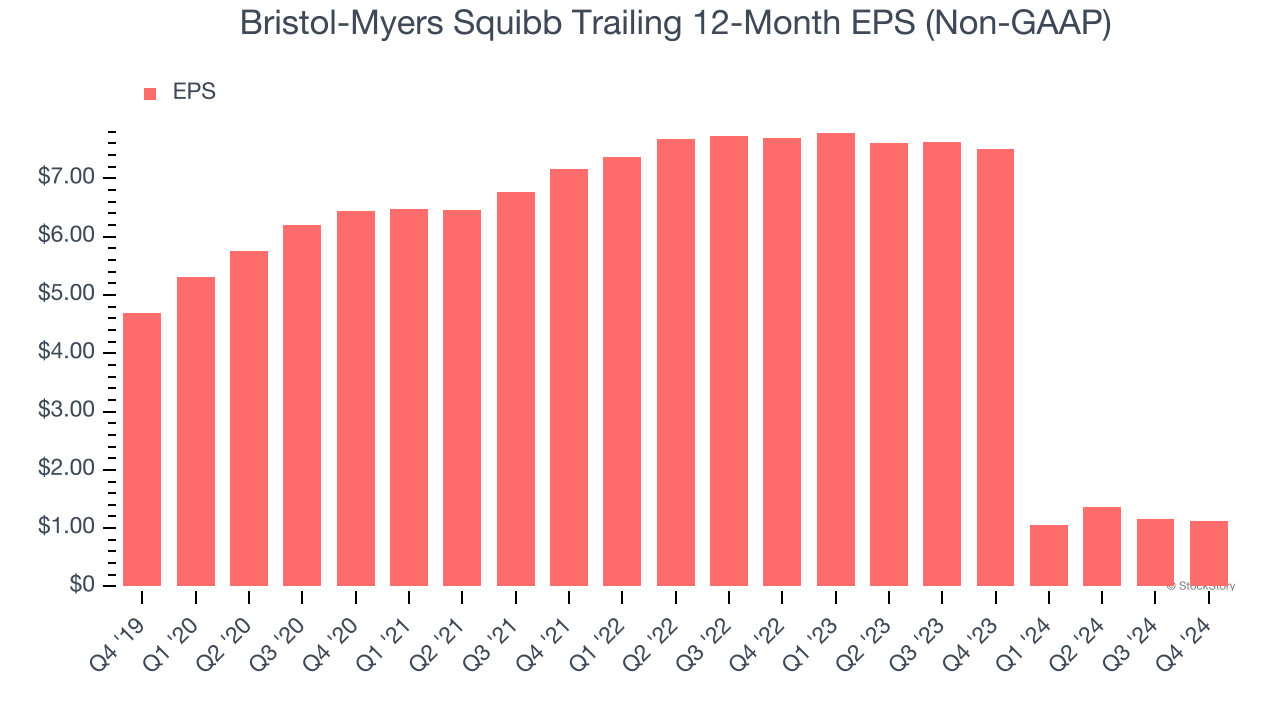
We can take a deeper look into Bristol-Myers Squibb’s earnings to better understand the drivers of its performance. As we mentioned earlier, Bristol-Myers Squibb’s adjusted operating margin declined by 40.5 percentage points over the last five years. Its share count also grew by 6.2%, meaning the company not only became less efficient with its operating expenses but also diluted its shareholders. 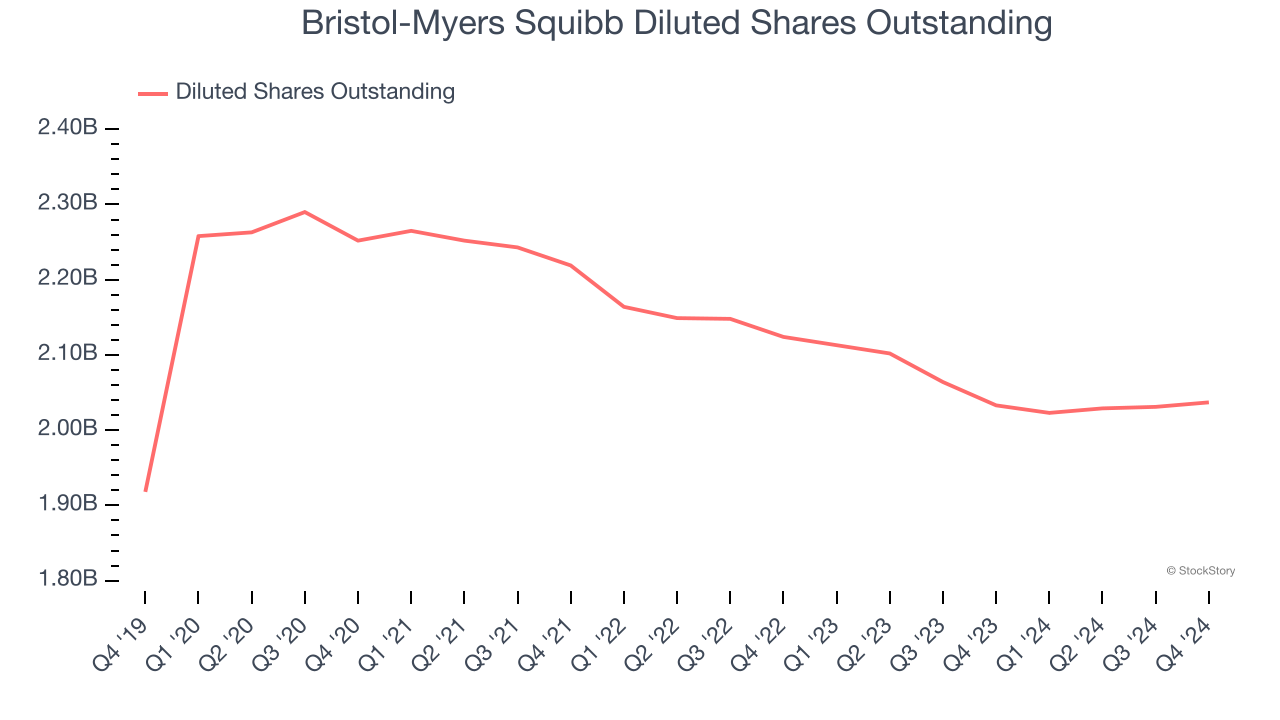
In Q4, Bristol-Myers Squibb reported EPS at $1.67, down from $1.70 in the same quarter last year. Despite falling year on year, this print easily cleared analysts’ estimates. Over the next 12 months, Wall Street expects Bristol-Myers Squibb’s full-year EPS of $1.13 to grow 514%.
Key Takeaways from Bristol-Myers Squibb’s Q4 Results
We liked that Bristol-Myers Squibb beat analysts’ expectations for revenue and EPS this quarter. On the other hand, its full-year EPS guidance missed significantly and its full-year revenue guidance also fell short of Wall Street’s estimates, and this weighed on shares. Overall, this was a softer quarter. The stock traded down 4.2% to $57.19 immediately after reporting.
Big picture, is Bristol-Myers Squibb a buy here and now? If you’re making that decision, you should consider the bigger picture of valuation, business qualities, as well as the latest earnings. We cover that in our actionable full research report which you can read here, it’s free.

